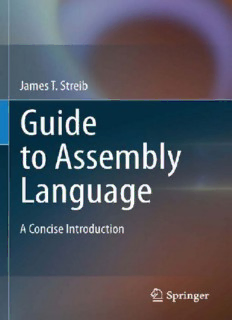Table Of ContentGuidetoAssemblyLanguage
James T. Streib
Guide to Assembly
Language
A Concise Introduction
123
ProfessorJamesT.Streib
IllinoisCollege
DepartmentofComputerScience
1101W.CollegeAve.
Jacksonville,Illinois62650
USA
[email protected]
ISBN978-0-85729-270-4 e-ISBN978-0-85729-271-1
DOI10.1007/978-0-85729-271-1
SpringerLondonDordrechtHeidelbergNewYork
BritishLibraryCataloguinginPublicationData
AcataloguerecordforthisbookisavailablefromtheBritishLibrary
LibraryofCongressControlNumber:2011922159
©Springer-VerlagLondonLimited2011
Apart from any fair dealing for the purposes of research or private study, or criticism or review, as
permittedundertheCopyright,DesignsandPatentsAct1988,thispublicationmayonlybereproduced,
storedortransmitted,inanyformorbyanymeans,withthepriorpermissioninwritingofthepublishers,
or in the case of reprographic reproduction in accordance with the terms of licenses issued by the
CopyrightLicensingAgency.Enquiriesconcerningreproductionoutsidethosetermsshouldbesentto
thepublishers.
Theuseofregisterednames,trademarks,etc.,inthispublicationdoesnotimply,evenintheabsenceof
aspecificstatement,thatsuchnamesareexemptfromtherelevantlawsandregulationsandtherefore
freeforgeneraluse.
Thepublishermakesnorepresentation,expressorimplied,withregardtotheaccuracyoftheinformation
containedinthisbookandcannotacceptanylegalresponsibilityorliabilityforanyerrorsoromissions
thatmaybemade.
Printedonacid-freepaper
SpringerispartofSpringerScience+BusinessMedia(www.springer.com)
Preface
Purpose
The purpose of this text is to assist one in learning how to program in Intel assembly
languageinaminimalamountoftime.Inaddition,throughprogrammingthereaderlearns
moreaboutthecomputerarchitectureoftheIntel32-bitprocessorandalsotherelationship
betweenhigh-levellanguagesandlow-levellanguages.
Need
Inthepast,manydepartmentshavehadtwoseparatecourses:oneinassemblylanguage
programming (sometimes called computer systems) and a second course in computer
organizationandarchitecture.Withtoday’scrowdedcurriculums,thereissometimesjust
one course in the computer science curriculum in computer organization and architec-
ture, where various aspects of both courses are included in the one course. The result
might be that unfortunately there is not enough coverage concerning assembly language
programming.
ImportanceofAssemblyLanguage
Althoughtheneedforassemblylanguageprogrammershasdecreased,theneedtounder-
stand assembly language has not, and the reasons why one ought to learn to program in
assemblylanguageincludethefollowing:
• Sometimesjustreadingaboutassemblylanguageisnotenough,andonemustactually
writeassemblylanguagecodetounderstanditthoroughly(althoughthecodedoesnot
havetobeextremelycomplicatedortrickytogainthisbenefit).
• Although some high-level languages include low-level features, there are times when
programming in assembly language can be more efficient in terms of both speed and
memory.
v
vi Preface
• Programminginassemblylanguagehasthesamebenefitsasprogramminginmachine
language, except it is easier. Further one can gain some first-hand knowledge into
the nature of computer systems, organization, and architecture from a software
perspective.
• Having knowledge of low-level programming concepts helps one understand how
high-level languages are implemented and various related compiler construction
concepts.
ComparisontoOtherComputerOrganizationandAssemblyLanguageTextbooks
Many textbooks on computer organization have only a few sections or chapters dealing
withassemblylanguageandasaresulttheymightnotcovertheaspectsofassemblylan-
guagethoroughlyenough.Also,insteadofdiscussingarealassemblylanguage,theymight
just use a hypothetical assembly and machine language. Although this can be helpful in
understandingsomeofthebasicconcepts,thestudentmightneitherseetherelevancenor
appreciatemanyoftheimportantconceptsofarealassemblylanguage.
Ontheotherhand,thereareanumberofassemblylanguagetextsthatgointosignificant
detailwhichcaneasilyfillanentiresemesterandalmostwarrantatwo-semestersequence.
Unfortunately,someofthemorecomprehensiveassemblylanguagetextsmightnotbethe
best choice for learning to program in assembly language due to the same reasons that
makethemexcellentcomprehensivetexts.
Thiscurrenttextdoesnotattempttofilltheneedsofeitherofthesetwopreviousvari-
etiesoftexts,becauseitfallsbetweenthescopesofthesetwotypesoftexts.Thepurpose
ofthistextistoprovideaconciseintroductiontothefundamentalsofassemblylanguage
programmingandasaresult,itcanservewellaseitherastand-alonetextoracompanion
texttothecurrentpopularcomputerorganizationtexts.
FeaturesofThisText
The primary goal of this text is to get the student programming in assembly language
asquicklyaspossible.Someofthesefeaturesthatmakethispossibleincludesimplified
register usage, simplified input/output using C-like statements, and the use of high-level
control structures. All of these features help the reader begin programming quickly and
reinforcemanyoftheconceptslearnedinpreviouscomputersciencecourses.Also,many
ofthecontrolstructuresareimplementedwithouttheuseofhigh-levelstructurestoallow
readerstounderstandhowtheyareactuallyimplemented.Further,manyoftheassembly
language code segments are preceded by C program code segments to help students see
therelationshipsbetweenhigh-levelandlow-levellanguages.Othernotablefeaturesatthe
endofeachchapterincludethefollowing:
• One or more complete programs illustrating many of the concepts introduced in that
chapter.
Preface vii
• Chapter summaries, which by themselves do not substitute for reading a chapter, but
after reading a chapter they serve as nice review for students preparing for a quiz or
exam.
• Exercises composed of a variety of questions, from short answer to programming
∗
assignments.Itemsmarkedwithan havesolutionsinAppendixE.
BriefOverviewoftheChaptersandAppendices
If this text is used in conjunction with another text in a computer organization course,
thenthereisapotentialforsomeduplicationbetweenthetexts.Forexample,manytexts
inassemblylanguagebeginwithanintroductiontobinaryarithmetic,whichofcourseis
incredibly important in a low-level language. However, should this text be used in con-
junctionwithacomputerorganizationtext,thenmanyofthoseconceptswillhavealready
beenintroduced.Asaresult,thistextbeginsattheoutsettogetstudentsintoprogramming
quicklyandintroducesorreviewsbinaryonanas-neededbasis.However,shouldthistext
beusedasastand-alonetext,thenAppendixBintroducesbinarynumbers,hexadecimal
numbers,conversions,logic,andarithmeticinmoredetail,shouldtheinstructororstudent
wishtoexaminethismaterialfirst.Whatfollowsisabriefoverviewofthechaptersandthe
appendices:
• Chapter1providesanoverviewofassemblylanguageandanintroductiontothegeneral
purposeregisters.
• Chapter2introducesthereadertoinput/outputinassemblylanguage,specificallyusing
theCprogramminglanguagescanfandprintfinstructions.
• Chapter3explainsbasicarithmeticinassemblylanguage,includingaddition,subtrac-
tion,multiplication,division,andoperatorprecedence.
• Chapter4showshowtoimplementselectionstructuresinassemblylanguage,suchas
if-then,if-then-else,nestedifstructures,andthecase(switch)structure.
• Chapter 5 continues with iteration structures, specifically the pre-test, post-test, and
definiteiterationsloopstructures,alongwithnestedloops.
• Chapter6introducesthelogic,shift,arithmeticshift,rotate,andstackinstructions.
• Chapter7discussesprocedures,introducesmacros,andexplainsconditionalassembly.
• Chapter8presentsarrays,sequentialsearching,andtheselectionsort.
• Chapter 9 discusses strings, string instructions, arrays of strings, and comparisons of
strings.
• Chapter10introducesmachinelanguagefromadiscoveryperspectiveandcanserveas
anintroductiontosomeoftheprinciplesofcomputerorganizationoritmightbeused
asasupplementtoacompanioncomputerorganizationtext(optional).
• Appendix A illustrates how to install and assemble programs using Visual C++ and
MASM.
• Appendix B provides an overview of binary and hexadecimal conversions, logic, and
arithmetic. The first three chapters of the text require limited use of binary and hex-
adecimalnumbers,soonemightnotneedtoreadthisappendixuntillaterinthecourse.
viii Preface
However,Chapter6requiresextensiveuseofbinarynumbersandlogic.Dependingon
thereader’sbackground,thisappendixshouldbereadpriortothatchapter.Ifnotcov-
ered elsewhere or it has been a while since one has studied numbering systems, this
appendix can serve as a good introduction or a good review, respectively. If one has
hadpreviousexposuretothesetopicsinapreviouscourse,concurrentcourse,orfrom
anothertextbookinthesamecourse,thenthisappendixcanbeskipped.
• AppendixCisaglossaryoftermsfirstintroducedinitalicsinthetext.Thedescriptions
oftermsinglossaryshouldnotbeusedinlieuofthecompletedescriptionsinthetext
butrathertheyserveasaquickreviewandreminderofthebasicmeaningofvarious
terms.Shouldamorecompletedescriptionbeneeded,theindexcanguidethereaderto
theappropriatepageswherethetermsarediscussedinmoredetail.
• AppendixDsummarizestheassemblylanguageinstructionsintroducedinthistext.
• AppendixEprovidesanswerstoselectedexercisesmarkedwithan∗thatappearatthe
endofeachchapterandattheendofAppendixB.
Scope
Thistextincludesthenecessaryfundamentalsofassemblylanguagetoallowittobeused
aseithera stand-alonetextinaone-semesterassemblylanguagecourseoracompanion
textinacomputerorganizationandarchitecturecourse.Aswithanytext,decisionsthen
mustbemadeonwhatshouldbeincluded,excluded,emphasized,anddeemphasized.This
textisnoexceptioninthatitdoesnotincludeeveryidiosyncrasyofassemblylanguageand
thusitmightnotcontainsomeofthefavoritesub-topicsofvariousinstructors.Someof
thesemightinclude16-bitprocessing,floatingpointprocessing,andWindowsprogram-
mingamongothers,buttheseofcoursecanbesupplementedattheinstructor’sdiscretion.
However,whatisgainedisthatreadersshouldbeabletowritelogicallycorrectprograms
inaminimalamountoftime,whichistheoriginalintentofthistext.
The Intel architecture is used because of its wide availability and MASM (Microsoft
Assembler)isused due toa numberofhigh-levelcontrolstructuresthatare availablein
thatassembler.NotethatJavaisaregisteredtrademarkofOracleand/oritsaffiliates,Intel
386andPentiumaretrademarksofIntelCorporation,andVisualStudio,VisualC++,and
MASM(MicrosoftAssembler)areregisteredtrademarksofMicrosoftCorporation.
Audience
Itisassumedthatthereaderofthisbookhascompletedatwo-semesterintroductorycourse
sequenceinahigh-levellanguagesuchasC,C++,orJava.Althoughastudentmightbe
abletousethistextonlyafteraone-semestercourse,anadditionalsemesterofprogram-
minginahigh-levellanguageisusuallypreferredtoallowforbetterunderstandingofthe
materialduetoincreasedprogrammingskills.
Preface ix
Acknowledgments
TheauthorwishestoacknowledgehiseditorWayneWheelerforhisassistance;thankhis
reviewers Mark E. Bollman of Albion College, James W. Chaffee of the University of
Iowa,BrendaTuomiLitkaofLorasCollege,TakakoSomaofIllinoisCollege,andCurtM.
WhiteofDePaulUniversityfortheirsuggestions;recognizethecomputersciencestudents
of Illinois College for examining various sections of the text in the classroom; offer a
specialthankstohiswifeKimberlyA.StreibandsonDanielM.Streibfortheirpatience;
andlastlyonapersonalnotededicatethisworktothememoryofbothhismotherDorisG.
StreibandsisterLynnA.Streib.
Feedback
Aswithanyworkthepossibilityoferrorsexists.Anycomments,corrections,orsugges-
tions are welcome and should be sent to the e-mail address listed below. In addition to
copiesofthecompleteprogramsattheendofeachchapter,anysignificantcorrectionscan
alsobefoundattheWebsitelistedbelow.
IllinoisCollege JamesT.Streib
Jacksonville,Illinois E-mail:[email protected]
October2010 Website:http://www2/jtstreib/guide
Description:stored or transmitted, in any form or by any means, with the prior permission in writing of . Exercises composed of a variety of questions, from short answer to numbers, conversions, logic, and arithmetic in more detail, should the Chapter 2 introduces the reader to input/output in assembly langu

